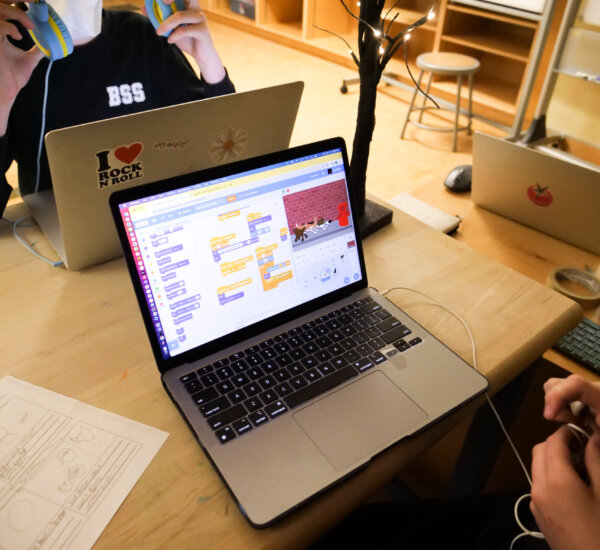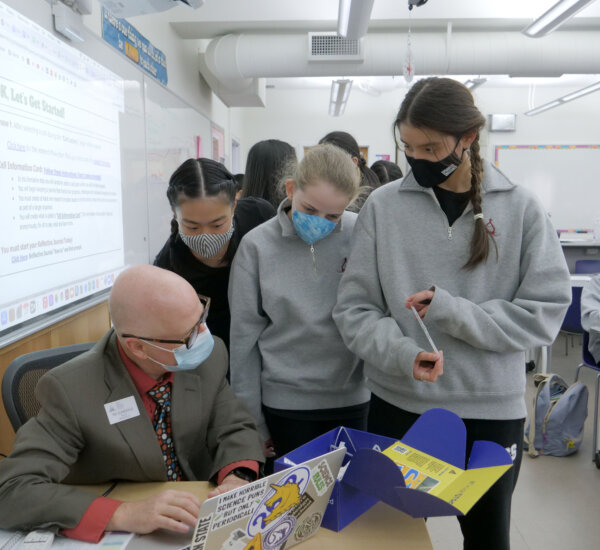In a brightly lit room in the BSS Learning Commons, a small group of Junior School students are gathered around a long table to learn how to analyze words using colourful miniature blocks.
Junior School Learning Resource Specialist, Aida Fahoum, reminds students that for the purposes of the class, the red block will always represent the vowel sound. “Take a look at my mouth, the word is /r/, /e/, /s/, /t/” says Ms. Fahoum. The students repeat the word and look down to find blocks that will represent the consonant and vowel phonemes (sounds) in the correct sequence for the word they’ve been tasked with spelling. Once students have analyzed the sequence of sounds, they are invited to think of the graphemes (letters and letter combinations) that can represent the sounds they perceive. Students are now ready to record the spelling, and shortly after notice how affixes (prefixes and suffixes) may be added to grow the word’s family, allowing for use in a variety of contexts.
Literacy Education in the Junior School
The methods to teach reading and spelling in the Junior School help students to discriminate sounds and letters, and support students as they build their reading, spelling and thinking skills in the classroom. To build literacy skills in younger students, educators are adopting a number of strategies and approaches. One of those approaches is referred to as Word Inquiry, which helps students understand the interrelationships between phonology (sound), morphology (structure), and etymology (history) in English spelling. Through this approach, students understand how the spelling of a word is organized to represent not merely sound but a word’s meaning, structure, relatives, and evolution over time.
“The word inquiry approach helps to illuminate the richness of the English language and supports not only reading and spelling skills, but an understanding of the language system,” says Ms. Fahoum. As a result of the approach, educators are beginning to see significant contributions to reading and spelling and comprehension skills. The Junior School teachers have also taken time to reflect and review the recent Ontario Human Rights Commission’s “Right to Read” Inquiry, which revealed an “urgent need to improve reading and other student achievement outcomes in Ontario.” Aligned with the recommendations in the report, the Junior School is ensuring that explicit and systematic instruction plays a key role in early literacy education. Much like BSS does with the Ontario Curriculum, the school has worked to surpass the report’s recommendations. Incorporating the process of Word Inquiry from the earliest grades is one way BSS goes beyond the recommendations. Because the school believes that children are capable of understanding that English spelling represents more than just sound, instruction is able to be more than explicit and systematic, but comprehensive as well.
“Our response to the inquiry alongside our ongoing interpretation of the ever-evolving research in reading education have moved us to enhance our instruction, review our assessment tools, and think deeply about our intervention practices,” says Ms. Fahoum.
Documenting the Learning Journey
The Junior School is inspired by the Reggio Emilia Approach, which sees students as competent and capable of developing strong relationships, and understanding the world in complex ways. Documentation is a key principle of the Reggio Emilia Approach, which makes visible the group learning processes. Using photographs, videos, and through note taking, teachers are able to track the progress of a students learning. This is especially useful when teaching students’ how to read. Documentation also enables teachers to interpret the children’s expressions and responses to information, and supports them in determining next steps to best support the learning of the group.
Tools for Teaching
Through explorations and investigations into letters and word structure, students’ verbal reasoning abilities, and understanding of how language works and how it has evolved are deepened. To support the development of reading skills, Grade 1 students have access to resources such as decodable texts, which provide opportunities to practice reading by applying their orthographic knowledge, (the understanding of how words are spelled) alongside their understanding of how words come together to produce meaning. Rather than encountering words in isolation from their context, or simply being asked to memorize them, Grade 1 students learn how to read words, analyze them closely and inquire about their meaning based on their own prior knowledge.
Skills and Outcomes
The Junior School’s approach to learning encourages students to develop self-awareness, grit, voice and leadership, some key Signature of a BSS Girl attributes. “If [students] feel intimidated, if they feel there’s only one way to answer a question, that there is only one or two ways to show their understanding, they’re going to close down. Openness creates more opportunity for exploration and creativity, therefore success and growth,” says Catherine Hant, Principal of the Junior School.


